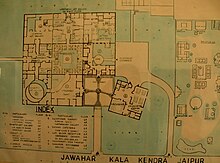Vaastu Shastra - Modern adaptations n usages
Modern adaptations and usage

Vastu Shastra-inspired plan adapted and evolved by modern architectCharles Correa in the design of Jawahar Kala Kendra, Jaipur, Rajasthan.[10][43]
Vastu sastra represents a body of ancient concepts and knowledge to many modern architects, a guideline but not a rigid code.[10][15] The square-grid mandala is viewed as a model of organization, not as a ground plan. The ancient Vastu sastra texts describe functional relations and adaptable alternate layouts for various rooms or buildings and utilities, but do not mandate a set compulsory architecture. Sachdev and Tillotson state that the mandala is a guideline, and employing the mandala concept of Vastu sastra does not mean every room or building has to be square.[10] The basic theme is around core elements of central space, peripheral zones, direction with respect to sunlight, and relative functions of the spaces.[10][15]
During the colonial rule period of India, town planning officials of the British Raj did not consider Vastu Vidya, but largely grafted Islamic Mughal era motifs and designs such as domes and arches onto Victorian-era style buildings without overall relationship layout.[16][44] This movement, later known as the Indo-Saracenic style, is found in chaotically laid out, but externally grand structures in the form of currently used major railway stations, harbors, tax collection buildings, and other colonial offices in South Asia.[16]
Vastu sastra vidya was ignored, during colonial era construction, for several reasons. These texts were viewed by 19th and early 20th century architects as archaic, the literature was inaccessible being in an ancient language not spoken or read by the architects, and the ancient texts assumed space to be readily available.[15][16] In contrast, public projects in the colonial era were forced into crowded spaces and local layout constraints, and the ancient Vastu sastra were viewed with prejudice as superstitious and rigid about a square grid or traditional materials of construction.[16]Sachdev and Tillotson state that these prejudices were flawed, as a scholarly and complete reading of the Vastu sastra literature amply suggests the architect is free to adapt the ideas to new materials of construction, local layout constraints and into a non-square space.[16][45] The design and completion of a new city of Jaipur in early 1700s based on Vastu sastra texts, well before any colonial era public projects, was one of many proofs.[16][45] Other examples include modern public projects designed byCharles Correa such as Jawahar Kala Kendra in Jaipur, and Gandhi Ashram in Ahmedabad.[10][43]
Klaus-Peter Gast states that the principles of Vastu Shastras is witnessing a major revival and wide usage in the planning and design of individual homes, residential complexes, commercial and industrial campuses, and major public projects in India, along with the use of ancient iconography and mythological art work incorporated into the Vastu vidya architectures.[17][43]
Vastu and superstition
See also: Superstition in India § Vastu_Shastra
The use of Vastu shastra and Vastu consultants in modern home and public projects is controversial.[45]
Vastu Shastra is considered as pseudoscience by rationalists like Narendra Nayak of Federation of Indian Rationalist Associations.[46] Scientist and astronomerJayant Narlikar considers Vastu Shastra as pseudoscience and writes that Vastu does not have any "logical connection" to the environment.[6] One of the examples cited by Narlikar arguing the absence of logical connection is the Vastu rule, "sites shaped like a triangle ... will lead to government harassment, ... parallelogram can lead to quarrels in the family." Narlikar notes that sometimes the building plans are changed and what has already been built is demolished to accommodate for Vastu rules.[6] Regarding superstitious beliefs in Vastu, Science writer Meera Nanda cites the case of N.T.Rama Rao the ex-chief minister of Andhra Pradesh, who sought the help of Vastu consultants for his political problems. Rama Rao was advised that his problems would be solved if he entered his office from an east facing gate. Accordingly, a slum on the east facing side of his office was ordered to be demolished, to make way for his car's entrance.[47][48] The knowledge of Vastu consultants is questioned by Pramod Kumar, "Ask the Vaastu folks if they know civil engineering or architecture or the local government rules on construction or minimum standards of construction to advise people on buildings. They will get into a barrage of "ancient" texts and "science" that smack of the pseudo-science of astrology. Ask them where they were before the construction boom and if they will go to slum tenements to advise people or advise on low-cost community-housing—you draw a blank."[49]
No comments:
Post a Comment